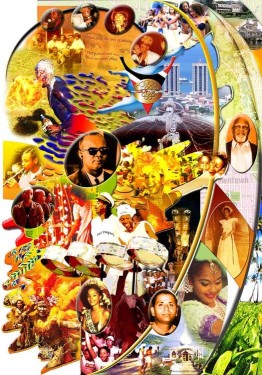Culture
The islands of Trinidad and Tobago are famous for their steel band music. This music is an important part of Carnival,the biggest celebration of the year on the islands. Carnival is a giant celebration that happens before Lent every year. There are man y parties and parades where thousands of people dress up in fantastic costumes and dance the calypso. It is very colorful and lots of fun for everyone.
y parties and parades where thousands of people dress up in fantastic costumes and dance the calypso. It is very colorful and lots of fun for everyone.
Trinidad and Tobago also have their own university and many local artists and writers. There are theaters that put on plays and many musical concerts and celebrations.
For sports, people enjoy soccer, rugby, cricket, horse racing, and boat racing. There are powerboat races between the two islands.
calypso music and the steelpan, which is widely claimed to be the only acoustic musical instrument invented during the 20th century. The diverse cultural and religious background allows for many festivities and ceremonies throughout the year. Other indigenous art forms include soca (a derivate of calypso),Parang (Venezuelan-influenced Christmas music),chutney,Rapso music, which was made famous by Cheryl Byron and pichakaree (musical forms which blend the music of the Caribbean and India) and the famous Limbo dance.
The artistic scene is vibrant. Trinidad and Tobago claims two Nobel Prize-winning authors, V.S. Naipaul and St Lucian-born Derek Walcott. Mas' designer Peter Minshall is renowned not only for his Carnival costumes, but also for his role in opening ceremonies of the Barcelona Olympics, the 1994 Football World Cup, the 1996 Summer Olympics and the 2002 Winter Olympics, for which he won an Emmy Award.Hasely Crawford was the first Trinidadian to win the Olympic Gold Medal in the men's 100 m dash.

| SCHEDULE OF CULTURAL AND RELIGIOUS EVENTS 2000 - 2030 | ||||
|---|---|---|---|---|
| YEAR | CARNIVAL | HOSAY | DIVALI | EID-UL-FITR |
| 2000 | Mar. 6 - 7 | Apr. 15 | Oct. 26 | Dec. 27 |
| 2001 | Feb. 26 - 27 | Apr. 4 | Nov. 14 | Dec. 16 |
| 2002 | Feb. 11 - 12 | Mar. 24 | Nov. 4 | Dec. 6 |
| 2003 | Mar. 3 - 4 | Mar. 13 | Oct. 25 | Nov. 25 |
| 2004 | Feb. 23 - 24 | Mar. 2 | Nov. 12 | Nov. 14 |
| 2005 | Feb. 7 - 8 | Feb. 19 | Nov. 1 | Nov. 4 |
| 2006 | Feb. 27 - 28 | Feb. 8 | Oct. 21 | Oct. 24 |
| 2007 | Feb. 19 - 20 | Jan. 30 | Nov. 9 | Oct. 13 |
| 2008 | Feb. 4 - 5 | Jan. 19 | Oct. 28 | Oct. 1 |
| 2009 | Feb. 23 - 24 | Jan. 7 & Dec. 27 | Oct. 17 | Sep. 20 |
| 2010 | Feb. 15 - 16 | Dec. 16 | Nov. 5 | Sep. 10 |
| 2011 | Mar. 7 - 8 | Dec. 6 | Oct. 26 | Aug. 31 |
| 2012 | Feb. 20 - 21 | Nov. 24 | Nov. 13 | Aug. 19 |
| 2013 | Feb. 11 - 12 | Nov. 14 | Nov. 3 | Aug. 9 |
| 2014 | Mar. 3 - 4 | Nov. 3 | Oct. 23 | Jul. 29 |
| 2015 | Feb. 16 - 17 | Oct. 23 | Nov. 11 | Jul. 18 |
| 2016 | Feb. 8 - 9 | Oct. 11 | Oct. 30 | Jul. 6 |
| 2017 | Feb. 27 - 28 | Oct. 1 | Oct. 19 | Jun. 25 |
| 2018 | Feb. 12 - 13 | Sep. 20 | Nov. 7 | Jun. 15 |
| 2019 | Mar. 4 - 5 | Sep. 10 | Oct. 27 | Jun. 5 |
| 2020 | Feb. 24 - 25 | Aug. 29 | Nov. 14 | May 24 |
| 2021 | Feb. 15 - 16 | Aug. 19 | Nov. 4 | May 13 |
| 2022 | Feb. 28 - Mar. 1 | Aug. 8 | Oct. 25 | May 2 |
| 2023 | Feb. 20 - 21 | Jul. 28 | Nov. 12 | Apr. 21 |
| 2024 | Feb. 12 - 13 | Jul. 16 | Nov. 1 | Apr. 10 |
| 2025 | Mar. 3 - 4 | Jul. 6 | Oct. 21 | Mar. 31 |
| 2026 | Feb. 16 - 17 | Jun. 25 | Nov. 8 | Mar. 20 |
| 2027 | Feb. 8 - 9 | Jun. 15 | Oct. 29 | Mar. 10 |
| 2028 | Feb. 28 - 29 | Jun. 4 | Oct. 17 | Feb. 27 |
| 2029 | Feb. 12 - 13 | May 24 | Nov. 5 | Feb. 15 |
| 2030 | Mar. 4 - 5 | May 13 | Oct. 26 | Feb. 4 |
More Details
- Trinidad Carnival 2015
- Trinidad Carnival 2013
- Trinidad Carnival 2014
- Trinidad Carnival Dates 2012-2020
- Trinidad Events Calender 2012-2030
- Trinidad Carnival Dates 2009
- Trinidad Easter 2014
- Trinidad Easter 2013
- Diwali in Trinidad and Tobago
- Trinidad Diwali Calendar 2000-2020
- Public Holidays 2013 - 2014
- Trinidad 2012 Calender
- Trinidad Latest Events News
- Getting to Trinidad and Tobago
- Trinidad and Tobago Climate
- Things to do in Trinidad
- Trinidad and Tobago Airports
- Advertise With Us
Trinidad Events
- Weymouth News Events - Tori Costa / Keiyana Marie Trinidad @ Myrtle - Wicked Local
- Weymouth News Events - Tori Costa / Keiyana Marie Trinidad @ Myrtle - Wicked Local
- Weymouth News Events - Tori Costa / Keiyana Marie Trinidad @ Myrtle - Wicked Local
- Weymouth News Events - Tori Costa / Keiyana Marie Trinidad @ Myrtle - Wicked Local
- Gasoline Lollipops: Trinidad Lounge - Colorado Community Media
- Fashion meets purpose at Rotary’s Hats & Heels gala - Trinidad Guardian
- Jodun: TTNL LIVE @Flamingle - Trinidad Express Newspapers
- Clinton Jackson - Trinidad Express Newspapers
- Chancey Williams: Trinidad's Legacy Rodeo - Colorado Community Media
- Chancey Williams: Trinidad's Legacy Rodeo - Colorado Community Media
